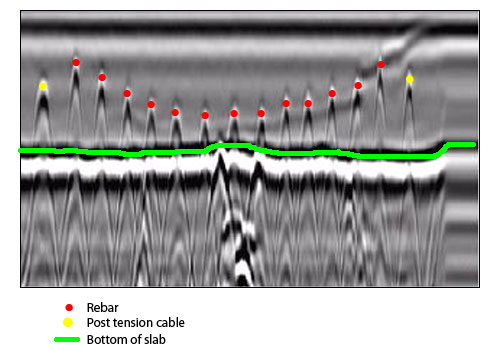Take Full Advantage Of Building Security with RainierGPR Concrete Scanning Solutions
Take Full Advantage Of Building Security with RainierGPR Concrete Scanning Solutions
Blog Article
Checking Out the Trick Benefits of Concrete Scanning in Building Projects
In the realm of modern-day construction techniques, the use of concrete scanning technology has actually arised as a critical device for ensuring job performance and structural stability. From enhancing safety procedures to properly detecting energies hidden underneath the surface area, the advantages of concrete scanning are complex. RainierGPR Concrete Scanning.
Enhanced Precaution
Making use of sophisticated concrete scanning technology improves safety measures on construction sites by offering accurate discovery of possible hazards concealed below the surface. This innovation allows construction teams to identify rebar, channels, post-tension cables, and other blockages prior to excavation or drilling, considerably minimizing the threat of mishaps. By identifying these aspects exactly, employees can stay clear of destructive essential structural components, thus preventing injuries, hold-ups, and expensive repair work.
Moreover, concrete scanning plays a crucial function in ensuring the stability of existing structures during remodellings or expansions. By finding weak points, voids, or degeneration within concrete aspects, designers can address these concerns proactively, boosting the overall security and longevity of the structure. This aggressive method not just alleviates the threat of structural failings however likewise lessens the potential for crashes triggered by unpredicted structural deficiencies.
In significance, the execution of concrete scanning innovation works as a proactive precaution that safeguards both building workers and the structural honesty of buildings, eventually contributing to the total success and effectiveness of building jobs. - RainierGPR Concrete Scanning
Accurate Discovery of Utilities
Concrete scanning innovation assists in precise recognition of below ground utilities, boosting construction website safety and security and effectiveness. Exact discovery of energies is crucial in building jobs to stop costly damages, project hold-ups, and most importantly, make sure the safety and security of workers and the general public. By utilizing sophisticated scanning technologies such as ground-penetrating radar (GPR) and electro-magnetic induction, building and construction groups can map out the area of buried pipelines, cords, and various other energies with high degrees of accuracy.

Time and Cost Effectiveness

Concrete scanning innovation enables building groups to accurately locate rebar, post-tension wires, and other ingrained objects within concrete frameworks. This accurate details helps in staying clear of pricey mistakes such as unintentional damages to important aspects throughout exploration, cutting, or coring tasks. In addition, by identifying potential dangers in advance, the demand for pricey repairs or remodel because of problems can be minimized, resulting in cost financial savings for the task.

Moreover, the capability to swiftly and accurately discover energies underneath the surface without causing any damage not just saves time but likewise stops costly interruptions to existing facilities. Generally, the moment and expense effectiveness benefits see this site of concrete scanning make it a vital tool for boosting building and construction task administration and execution.
Conservation of Architectural Stability
Protecting the structural honesty of structures and facilities is vital in making certain long-lasting stability and safety. Concrete scanning plays an important duty in this preservation process by permitting building and construction professionals to recognize prospective risks to the structural honesty of a building or framework prior to they escalate right into significant concerns. With using advanced scanning modern technologies such as ground-penetrating Check This Out radar (GPR) and electro-magnetic induction, building teams can non-invasively examine the condition of concrete frameworks, find rebar, post-tension cords, and various other embedded components, and determine any type of gaps, fractures, or deterioration within the concrete.
Improved Task Planning
In order to make sure the successful implementation of building tasks, thorough interest to detail and detailed planning are essential components that stem from a thorough understanding of the structural conditions recognized with concrete scanning. Boosted task preparation, facilitated by concrete scanning, enables construction groups to preemptively resolve prospective obstacles, assign sources more successfully, and establish practical timelines. By properly recognizing the location of rebar, post-tension cords, and various other ingrained things within concrete structures, job supervisors can develop more accurate building and construction strategies that minimize the threat of costly errors or hold-ups. In addition, the data gotten from concrete scanning makes it possible for stakeholders to make informed choices concerning architectural alterations, remodellings, or growths, leading to smoother job shifts and boosted overall task outcomes. Ultimately, integrating concrete scanning right into the project preparation stage boosts coordination among staff member, cultivates proactive problem-solving, and contributes to the effective distribution of building and construction tasks within click for more budget and timetable restraints.
Verdict
To conclude, concrete scanning uses countless benefits in building and construction jobs. By enhancing safety and security measures, properly finding utilities, improving time and cost efficiency, maintaining structural stability, and helping in project preparation, concrete scanning shows to be an essential tool for effective job execution. Its ability to mitigate threats, enhance performance, and make sure project stability makes it a vital asset for building and construction professionals.
In the realm of modern construction methods, the utilization of concrete scanning innovation has actually arised as a critical device for guaranteeing task performance and structural stability.Concrete scanning modern technology allows building and construction groups to accurately find rebar, post-tension wires, and other ingrained objects within concrete structures. Via the usage of sophisticated scanning modern technologies such as ground-penetrating radar (GPR) and electromagnetic induction, building teams can non-invasively evaluate the problem of concrete frameworks, situate rebar, post-tension cable televisions, and other embedded aspects, and recognize any type of spaces, fractures, or deterioration within the concrete.
In order to guarantee the successful implementation of construction jobs, precise focus to information and detailed planning are essential parts that stem from a detailed understanding of the architectural conditions determined with concrete scanning. Eventually, incorporating concrete scanning into the project planning phase boosts sychronisation among group members, fosters proactive problem-solving, and adds to the effective shipment of building and construction jobs within budget and schedule constraints.
Report this page